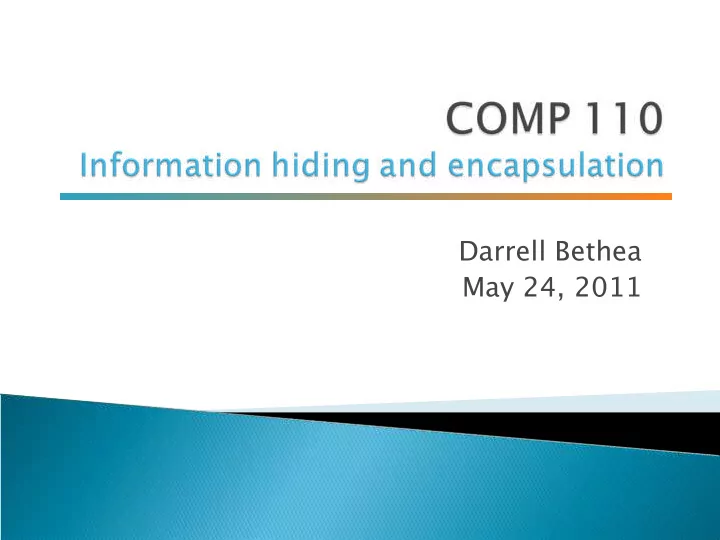

Darrell Bethea May 24, 2011
Midterm Thursday ◦ SN014 Program 3 due 5/31 ◦ Don’t forget about JarChecker.java 2
3
More about methods public/private Information hiding and encapsulation 4
Parameters are used to hold the value that you pass to the method Parameters can be used as (local) variables inside the method Parameters go inside public int square(int number) parentheses of { method header return number * number; } 5
Multiple parameters separated by commas public double getTotal(double price, double tax) { return price + price * tax; } 6
public class SalesComputer { public double getTotal(double price, double tax) { return price + price * tax; } // ... SalesComputer sc = new SalesComputer(); double total = sc.getTotal(“19.99”, Color.RED); double total = sc.getTotal(19.99); double total = sc.getTotal(19.99, 0.065); int price = 50; total = sc.getTotal(price, 0.065); Automatic typecasting 17
A method body can call another method ◦ Done the same way: objectName.method(); If calling a method in the same class, do not need objectName.: ◦ method(); Alternatively, use the this keyword ◦ this.method(); 8
Within a class definition, this is a name for the receiving object ◦ this.age ◦ this.major ◦ this.getAge() Frequently omitted, but understood to be there See book for details 9
public void setMajor() public int classYear; public: there is no restriction on how you can use the method or instance variable 10
private void setMajor() private int classYear; private: can not directly use the method or instance variable’s name outside the class 11
public class Student { public int classYear; private String major; } Student jack = new Student(); OK, classYear is public jack.classYear = 1; jack.major = “Computer Science”; Error!!! major is private 12
Hides instance variables and methods inside the class/object. The private variables and methods are still there, holding data for the object. Invisible to external users of the class ◦ Users cannot access private class members directly Information hiding 13
Force users of the class to access instance variables only through methods ◦ Gives you control of how programmers use your class Why is this important? 14
public class Rectangle Rectangle box = new Rectangle(); { box.setDimensions(10, 5); public int width; System.out.println(box.getArea()); public int height; public int area; // Output: 50 public void setDimensions( int newWidth, box.width = 6; int newHeight) System.out.println(box.getArea()); { width = newWidth; height = newHeight; // Output: 50, but wrong answer! area = width * height; } public int getArea() { return area; } } 15
How do you access private instance variables? Accessor methods (a.k.a. get methods, getters) ◦ Allow you to look at data in private instance variables Mutator methods (a.k.a. set methods, setters) ◦ Allow you to change data in private instance variables 16
public class Student { private String name; private int age; public void setName(String studentName) { name = studentName; } Mutators public void setAge(int studentAge) { age = studentAge; } public String getName() { return name; } Accessors public int getAge() { return age; } } 17
Helper methods that will only be used from inside a class should be private ◦ External users have no need to call these methods Encapsulation 18
Accelerate with the accelerator pedal Decelerate with the brake pedal Steer with the steering wheel Does not matter if: ◦ You are driving a gasoline engine car or a hybrid engine car ◦ You have a 4-cylinder engine or a 6-cylinder engine You still drive the same way 19
The interface is the same The underlying implementation may be di fg erent 20
A class interface tells programmers all they need to know to use the class in a program The implementation of a class consists of the private elements of the class definition ◦ private instance variables and constants ◦ private methods ◦ bodies of public methods 21
public class Rectangle public class Rectangle { { private int width; private int width; private int height; private int height; private int area; public void setDimensions( int newWidth, public void setDimensions( int newHeight) int newWidth, { int newHeight) width = newWidth; { height = newHeight; width = newWidth; } height = newHeight; area = width * height; } public int getArea() { return width * height; public int getArea() } { } return area; } } 22
Implementation should not a fg ect behavior described by interface ◦ Two classes can have the same behavior but di fg erent implementations 23
Class Definition Implementation: Interface: Private instance variables Private constants Comments Programmer Private Methods Headings of public methods Public defined constants Bodies of all methods Method definitions 24
Precondition - everything that needs to be true before method Postcondition - describes e fg ect of method call 25
You can omit for obvious methods ◦ get (accessor), set (mutator) … All other methods need pre and post conditions If you are unsure, write pre and post! 26
Comments before class definition (this is your header) Instance variables are private Provide public accessor and mutator methods Pre and post comments before methods Make helping methods private /**/ for user-interface comments and // for implementation comments 27
Variables are local to methods Instance variables are Global for all methods in a class 28
Recommend
More recommend